Senior Science Journalist

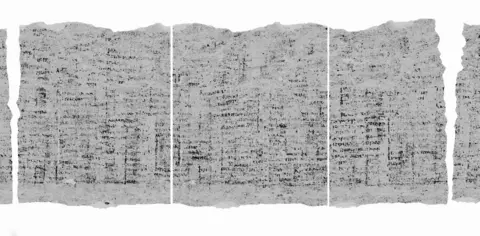 Vesuvius Challenge
Vesuvius ChallengeA badly burnt scroll from the Roman town of Herculaneum has been digitally “unwrapped”, providing the first look inside for 2,000 years.
The document, which looks like a lump of charcoal, was charred by the volcanic eruption of Mount Vesuvius in 79AD and is too fragile to ever be physically opened.
But now scientists have used a combination of X-ray imaging and artificial intelligence to virtually unfurl it, revealing rows and columns of text.
More work is needed to make the scroll fully legible to decipher its contents, but the team behind the project say the results are very promising.

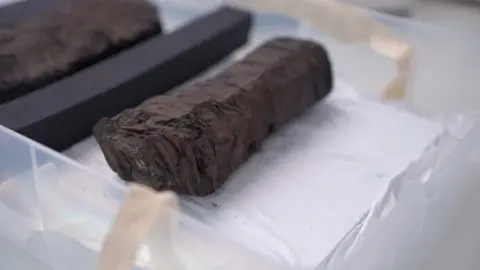 Bodleian Library
Bodleian Library“We’re confident we will be able to read pretty much the whole scroll in its entirety, and it’s the first time we’ve really been able to say that with high confidence,” said Stephen Parsons, project lead for the Vesuvius Challenge, an international competition attempting to unlock the Herculaneum scrolls.
Some letters are already clearly visible in the ancient text and the team believes it’s a work of philosophy.

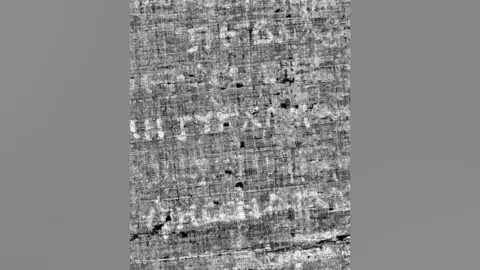 Vesuvius Challenge
Vesuvius ChallengeHundreds of carbonised scrolls were discovered in Herculaneum, which like its neighbour Pompeii was buried beneath metres of volcanic ash.
In the past, some of the documents, which are made from a thick paper-like material called papyrus, were prised open but they crumbled into pieces.
The University of Oxford’s Bodleian Library holds several of the scrolls. Thought to be unreadable, they had been left untouched for decades.
“We’ve never been convinced before that any of the techniques would be safe enough or effective enough to get any information from the scrolls,” explained Nicole Gilroy, head of book conservation.
But the promise of a hi-tech solution prompted the team to get one of the precious scrolls out of storage.

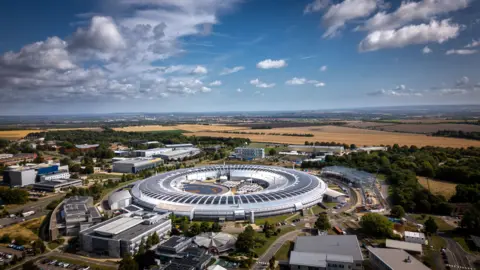 Tony Jolliffe/BBC
Tony Jolliffe/BBCIt was placed in a specially made case and taken to Diamond Light Source in Oxfordshire.
Inside this huge machine, which is called a synchrotron, electrons are accelerated to almost the speed of light to produce a powerful X-ray beam that can probe the scroll without damaging it.
“It can see things on the scale of a few thousandths of a millimetre,” explained Adrian Mancuso, director of physical sciences at Diamond.
The scan is used to create a 3D reconstruction, then the layers inside the scroll – it contains about 10m of papyrus – have to be identified.
“We have to work out which layer is different from the next layer so we can unroll that digitally,” said Dr Mancuso.
After that artificial intelligence is used to detect the ink. It’s easier said than done – both the papyrus and ink are made from carbon and they’re almost indistinguishable from each other.
So the AI hunts for the tiniest signals that ink might be there, then this ink is painted on digitally, bringing the letters to light.

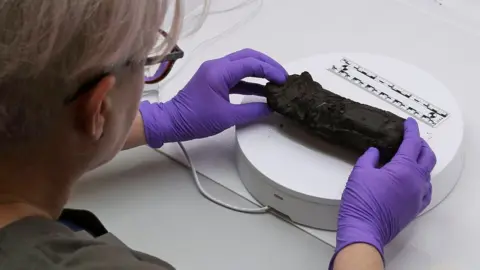 Bodleian library
Bodleian library“We can tell the entire scroll is full of text,” said Stephen Parsons.
“Now we can work on making it show up more clearly. We’re going to go from a handful of words to really substantial passages.”
Last year, a Vesuvius Challenge team managed to read about 5% of another Herculaneum scroll.
Its subject was Greek Epicurean philosophy, which teaches that fulfilment can be found through the pleasure of everyday things.
The Bodleian’s scroll is likely to be on the same subject – but the Vesuvius team is calling for more human and computing ingenuity to see if this is the case.
For Nicole Gilroy, the work is providing a link to the past.
“I just love that connection with whoever collected them, whoever wrote them, whoever rolled those scrolls up and put them on the shelves. There’s a real human aspect to it that I just think is really precious,” she said.
Source link